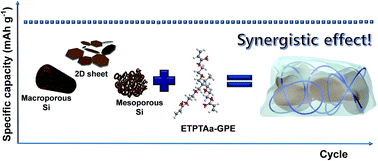An effective coupling of nanostructured Si and gel polymer electrolytes for high-performance lithium-ion battery anodes†
Abstract
Nanostructured silicon has garnered considerable attention as a promising lithium-ion battery anode material that can mitigate volume expansion-induced pulverization during electrochemical lithiation–delithiation reaction. However, the advantageous effect of the nanostructured silicon materials is often shadowed by electrochemically-vigorous liquid electrolytes. Herein, a variety of silicon particles featuring well-defined nanostructures were synthesized and then combined with chemically-crosslinked, triacrylate-based gel polymer electrolytes (GPEs), with an aim to pursue unprecedented synergistic coupling and its versatile applicability for high-performance silicon anodes. The silicon anode combined with the GPE showed a specific capacity of over 2000 mA h g−1 after 100 cycles, excellent discharge rate capability (capacity of 80% at 5.0C with respect to 0.2C), and volume change of 53% relative to a control system (silicon anode/liquid electrolyte). Excellent flexibility of the GPE with reliable electrochemical properties is believed to play a viable role as a mechanical cushion that can alleviate the stress and strain of silicon materials inevitably generated during repeated charge/discharge cycling. The nanostructured silicon/GPE-based coupling strategy presented herein opens a new way to enable a significant improvement in the electrochemical performance and long-term durability of high-capacity silicon anodes.


 Please wait while we load your content...
Please wait while we load your content...